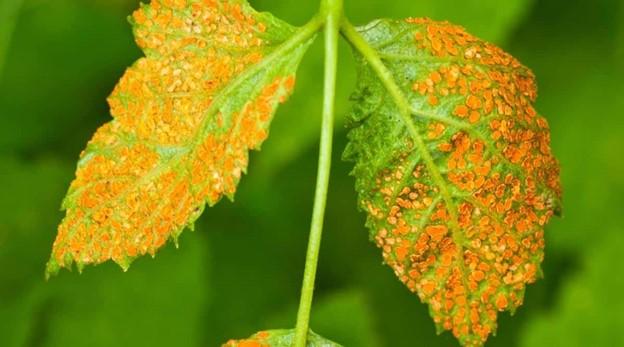
Fig. 1 Orange pustules on the underside of bramble leaves indicating infection with Orange rust. Photo: T. Sievers, Blumen Farm
Orange Rust is a bigger problem than usual this year in brambles
This has been a soggy May. With overcast skies and drizzle almost every day along with cooler than normal temperatures. This type of weather is great for foliar disease problems such as botrytis, but also for a disease called orange rust in brambles. Orange rust begins to appear a few weeks after plant emergence with the lower leaf surfaces becoming covered with blister-like masses of orange aeciospores (fig. 1). The disease is caused by two fungal pathogens that cause systemic infection throughout the blackberry. Infection takes place when it has been wet for more than 12 hours in a day and temperatures are between 43°F and 72°F. The fungus cannot infect if it is hot (85o F) or very dry.
While the telltale sign of this disease are bright orange pustules on the undersides of leaves other symptoms of infection include spindly, stunted, weak shoots that emerge from floricanes, chlorotic misshapen leaves and multiple spindly shoots growing from root buds. Sources of orange rust in established plantings often come from wild brambles along wooded edges, so if you have an established planting and see orange rust be sure to scout the wooded edges along your plantings to identify a possible wild source. There are two forms of orange rust, the one on black raspberry is caused by Arthuriomyces peckianus, while the form commonly found on blackberry is Gymnoconia nitens. All varieties of black raspberry and many varieties of erect blackberries are susceptible. Red raspberries are immune to orange rust.
Damage from orange rust can be significant. Even though infected plants seldom die, they are weakened and do not produce quality fruit. Consequently, they represent an almost total loss in yield. However, the good news is that the disease is usually sporadic, which helps growers to manage its spread. Rust overwinters on infected leaves on the soil surface and on old canes, so if rust gets established in your field, it will likely persist at low levels through the life of the planting. There are two periods of infection that are important for control, 3-4 weeks in the spring, around the time of shoot emergence, after the last frost, and about 3-6 weeks in the fall, from the time when primocane growth slows until first frost.
Since orange rust is a systemic fungal disease, management and control is mainly through removing infected plants entirely, including the roots. Once infected, a plant cannot be cured. Remove infected plants as soon as they appear in the spring before they release spores. Remove infected wild Rubus plants in the vicinity of your planting (these plants will show the orange pustules most strikingly). Any management practice that encourages air circulation within the canopy such as thinning canes within the row, removing floricanes immediately after harvest and weed management will aid in disease control by reducing the duration of leaf wetness. While using fungicides will not help with already infected plants they will help protect other neighboring plants from initial infection. Fungicides should be applied when the orange pustules are first seen, preferably before they release spores. If the field has a history of orange rust, sprays should be started before blisters appear. The best fungicide options are Rally (myclobutanil) and Tilt (propiconazole). Apply on a 10 to 14-day schedule – use the shorter interval in wet weather.
Apache is a cultivar that is considered to be resistant, or at least tolerant to orange rust, but of late this may not be the case. Other cultivars that have historically had a good tolerance include Cherokee, Cheyenne, Comanche, Ouachita, and Osage.
Resources: Cassandra Swett, Extension Specialist – Berry Pathology, University of Maryland.
This article appears in Volume 15, Issue 4 of the Vegetable and Fruit News.
Vegetable and Fruit News is a statewide publication for the commercial vegetable and fruit industries and is during the growing season from April through October. Subscribers will receive an email with the latest edition.
Subscribe